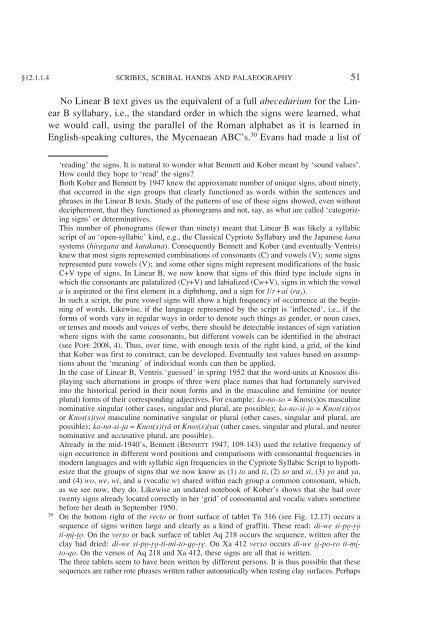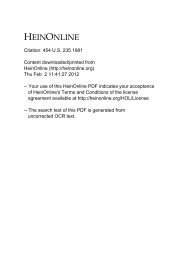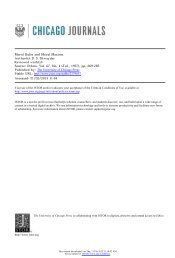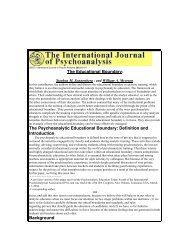A Companion to Linear B - The University of Texas at Austin
A Companion to Linear B - The University of Texas at Austin
A Companion to Linear B - The University of Texas at Austin
Create successful ePaper yourself
Turn your PDF publications into a flip-book with our unique Google optimized e-Paper software.
§12.1.1.4 SCRIBES, SCRIBAL HANDS AND PALAEOGRAPHY 51<br />
No <strong>Linear</strong> B text gives us the equivalent <strong>of</strong> a full abecedarium for the <strong>Linear</strong><br />
B syllabary, i.e., the standard order in which the signs were learned, wh<strong>at</strong><br />
we would call, using the parallel <strong>of</strong> the Roman alphabet as it is learned in<br />
English-speaking cultures, the Mycenaean ABC’s. 30 Evans had made a list <strong>of</strong><br />
‘reading’ the signs. It is n<strong>at</strong>ural <strong>to</strong> wonder wh<strong>at</strong> Bennett and Kober meant by ‘sound values’.<br />
How could they hope <strong>to</strong> ‘read’ the signs?<br />
Both Kober and Bennett by 1947 knew the approxim<strong>at</strong>e number <strong>of</strong> unique signs, about ninety,<br />
th<strong>at</strong> occurred in the sign groups th<strong>at</strong> clearly functioned as words within the sentences and<br />
phrases in the <strong>Linear</strong> B texts. Study <strong>of</strong> the p<strong>at</strong>terns <strong>of</strong> use <strong>of</strong> these signs showed, even without<br />
decipherment, th<strong>at</strong> they functioned as phonograms and not, say, as wh<strong>at</strong> are called ‘c<strong>at</strong>egorizing<br />
signs’ or determin<strong>at</strong>ives.<br />
This number <strong>of</strong> phonograms (fewer than ninety) meant th<strong>at</strong> <strong>Linear</strong> B was likely a syllabic<br />
script <strong>of</strong> an ‘open-syllabic’ kind, e.g., the Classical Cypriote Syllabary and the Japanese kana<br />
systems (hiragana and k<strong>at</strong>akana). Consequently Bennett and Kober (and eventually Ventris)<br />
knew th<strong>at</strong> most signs represented combin<strong>at</strong>ions <strong>of</strong> consonants (C) and vowels (V); some signs<br />
represented pure vowels (V); and some other signs might represent modific<strong>at</strong>ions <strong>of</strong> the basic<br />
C+V type <strong>of</strong> signs. In <strong>Linear</strong> B, we now know th<strong>at</strong> signs <strong>of</strong> this third type include signs in<br />
which the consonants are pal<strong>at</strong>alized (Cy+V) and labialized (Cw+V), signs in which the vowel<br />
a is aspir<strong>at</strong>ed or the first element in a diphthong, and a sign for l/r + ai (ra 3).<br />
In such a script, the pure vowel signs will show a high frequency <strong>of</strong> occurrence <strong>at</strong> the beginning<br />
<strong>of</strong> words. Likewise, if the language represented by the script is ‘inflected’, i.e., if the<br />
forms <strong>of</strong> words vary in regular ways in order <strong>to</strong> denote such things as gender, or noun cases,<br />
or tenses and moods and voices <strong>of</strong> verbs, there should be detectable instances <strong>of</strong> sign vari<strong>at</strong>ion<br />
where signs with the same consonants, but different vowels can be identified in the abstract<br />
(see POPE 2008, 4). Thus, over time, with enough texts <strong>of</strong> the right kind, a grid, <strong>of</strong> the kind<br />
th<strong>at</strong> Kober was first <strong>to</strong> construct, can be developed. Eventually test values based on assumptions<br />
about the ‘meaning’ <strong>of</strong> individual words can then be applied.<br />
In the case <strong>of</strong> <strong>Linear</strong> B, Ventris ‘guessed’ in spring 1952 th<strong>at</strong> the word-units <strong>at</strong> Knossos displaying<br />
such altern<strong>at</strong>ions in groups <strong>of</strong> three were place names th<strong>at</strong> had fortun<strong>at</strong>ely survived<br />
in<strong>to</strong> the his<strong>to</strong>rical period in their noun forms and in the masculine and feminine (or neuter<br />
plural) forms <strong>of</strong> their corresponding adjectives. For example: ko-no-so = Knos(s)os masculine<br />
nomin<strong>at</strong>ive singular (other cases, singular and plural, are possible); ko-no-si-jo = Knos(s)iyos<br />
or Knos(s)iyoi masculine nomin<strong>at</strong>ive singular or plural (other cases, singular and plural, are<br />
possible); ko-no-si-ja = Knos(s)iya or Knos(s)iyai (other cases, singular and plural, and neuter<br />
nomin<strong>at</strong>ive and accus<strong>at</strong>ive plural, are possible).<br />
Already in the mid-1940’s, Bennett (BENNETT 1947, 109-143) used the rel<strong>at</strong>ive frequency <strong>of</strong><br />
sign occurrence in different word positions and comparisons with consonantal frequencies in<br />
modern languages and with syllabic sign frequencies in the Cypriote Syllabic Script <strong>to</strong> hypothesize<br />
th<strong>at</strong> the groups <strong>of</strong> signs th<strong>at</strong> we now know as (1) <strong>to</strong> and ti, (2) so and si, (3) yo and ya,<br />
and (4) wo, we, wi, and u (vocalic w) shared within each group a common consonant, which,<br />
as we see now, they do. Likewise an und<strong>at</strong>ed notebook <strong>of</strong> Kober’s shows th<strong>at</strong> she had over<br />
twenty signs already loc<strong>at</strong>ed correctly in her ‘grid’ <strong>of</strong> consonantal and vocalic values sometime<br />
before her de<strong>at</strong>h in September 1950.<br />
30 On the bot<strong>to</strong>m right <strong>of</strong> the rec<strong>to</strong> or front surface <strong>of</strong> tablet Tn 316 (see Fig. 12.17) occurs a<br />
sequence <strong>of</strong> signs written large and clearly as a kind <strong>of</strong> graffiti. <strong>The</strong>se read: di-we si-pœ-®œ<br />
ti-μî-†œ. On the verso or back surface <strong>of</strong> tablet Aq 218 occurs the sequence, written after the<br />
clay had dried: di-we si-pœ-®œ-ti-mi-<strong>to</strong>-qœ-®ê. On Xa 412 verso occurs di-we Òî-po-ro ti-μî<strong>to</strong>-qo.<br />
On the versos <strong>of</strong> Aq 218 and Xa 412, these signs are all th<strong>at</strong> is written.<br />
<strong>The</strong> three tablets seem <strong>to</strong> have been written by different persons. It is thus possible th<strong>at</strong> these<br />
sequences are r<strong>at</strong>her rote phrases written r<strong>at</strong>her au<strong>to</strong>m<strong>at</strong>ically when testing clay surfaces. Perhaps

















